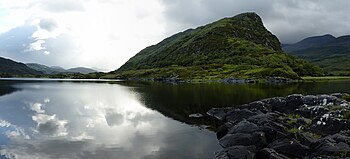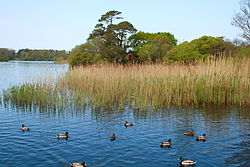Difference between revisions of "Lough Leane"
(Created page with "Lough Leane {{county|Kerry}} '''Lough Leane''' is the largest of the three Lakes of Killarney, covering 4,700 acres...") |
(→References) |
||
| Line 16: | Line 16: | ||
Lough Leane is a habitat for the critically endangered blunt-snouted Irish char (''Salvelinus obtusus'') and Killarney shad (''Alosa killarnensis''). | Lough Leane is a habitat for the critically endangered blunt-snouted Irish char (''Salvelinus obtusus'') and Killarney shad (''Alosa killarnensis''). | ||
| + | {{commons}} | ||
==References== | ==References== | ||
{{reflist}} | {{reflist}} | ||
Latest revision as of 20:50, 8 July 2020
Lough Leane is the largest of the three Lakes of Killarney, covering 4,700 acres. The River Laune flows from the lake into the Dingle Bay to the north-west.
The name of the lake is from the Irish language, Loch Léin meaning "Lake of learning", probably in reference to the monastery on Innisfallen Island, an island in the lake. Innisfallen was a centre of scholarship in the early Middle Ages, producing the Annals of Innisfallen and, according to legend, educating King Brian Boru.
Another historic site, a tower house called Ross Castle sits on Ross Island in the lake. Ross Island is rich in copper. Archaeological evidence suggests the island has been mined since the time of the Bronze Age Beaker People.[1][2]
Geography
Lough Leane is about 4,700 acres in size. It is also the largest body of fresh water in the region. It has become eutrophic as a result of phosphates from agricultural and domestic pollution entering Lough Leane Reedbed, an important habitat on the edge of Lough Leane. This nutrient enrichment has caused several algal blooms in recent years. The blooms have not yet had a severe effect on the lake's ecosystem. To prevent further pollution causing a permanent change in the lake's ecosystem, a review of land use in the catchment area is being carried out. Water quality in the lake appears to have improved since phosphates were removed from sewage in 1985. As of August 2007, several large hotels and businesses have stated their intention to stop using phosphate detergents, in an effort to preserve the quality of the lake water.
Lake cruises for tourists leave from Ross Castle, and boats can be hired for the trip to Innisfallen Island.
Wildlife
Lough Leane is a habitat for the critically endangered blunt-snouted Irish char (Salvelinus obtusus) and Killarney shad (Alosa killarnensis).
| ("Wikimedia Commons" has material about Lough Leane) |
References
- ↑ "Ross Island". nuigalway.ie. http://www.nuigalway.ie/ross_island/ross_island.htm. Retrieved 2014-04-11.
- ↑ J. P. N. Northover, W. O'Brien and S. Stos. "Lead Isotopes and Metal Circulation In Beaker/Early Bronze Age Ireland." The Journal of Irish Archaeology Vol. 10, (2001), pp. 25-47. Wordwell Ltd. Stable URL: https://www.jstor.org/stable/30001669

